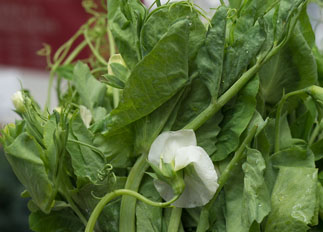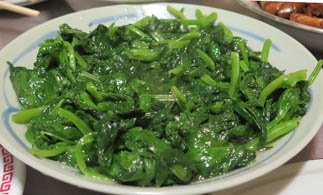Pea shoots Nutrition facts
Pea shoots are the young, tender leaves and furling vine tips of green or garden peas (Pisum sativum L.) Pea tendrils have a similar flavor to the pea and have a sweet flavor and crisp, light texture.
 |
| Pea tendrils. (Photo: USDA) |
Peas are cool-weather crops and should be planted in early spring or late summer.
To concentrate the plant energy on vine production, remove flowers to prevent the formation of pods.
Harvesting
Pea tendrils are ready for an early harvest in about 45 days from the seedling. If the main crop is aimed at pea tendrils, clip the tips of the pea plants down to 0.5 inches above the ground when plants are 3-7 inches tall.
Pea plants will continue to grow after this first harvest as long as one leaf node remains on the stem and will continue to grow by developing branches at the top leaf node.
Harvesting takes place several times. The first cutting is usually the best quality. However, the next 2-3 cuttings are also fine.
Pea tendrils are generally hand-harvested and bundled. Immediately after the harvest, precool them in ice water and keep them in cool, moist storage.
Before packing, gently shake off excess moisture so pea shoots are not wet when packed. Otherwise, post-harvest rots may ruin the shipment. Do not pack peas shoots tightly into boxes or crates as they bruise easily.
Health benefits of Pea shoots
Pea shoots and leaves are one of the very low-calorie vegetables. 100 g of fresh leaves hold just 27 calories. Nonetheless, they hold several vital phytochemicals, anti-oxidants, vitamins, and minerals that benefit overall health immensely.
Pea shoot greens are rich sources of flavonoid phytochemicals such as β-carotenes,, and xanthins. Together, these compounds have been found to counter the carcinogenic effects of estrogen and thus may offer protection against prostate, breast, cervical, colon, and ovarian cancers by their cancer-cell growth inhibition, and cytotoxic effects on cancer cells.
Fresh shoots are a rich source of folates. 100 g of fresh greens contain 91 µg or 22% of folates. This vitamin may help prevent neural tube defects in newborns when advised in anticipant mothers.
Pea tendrils are an excellent source of vitamin A. 100 g fresh leaves contain 1133 IU of vitamin A and 4100 µg of β-carotene. Carotenes convert into vitamin A in humans. Studies found that vitamin A and flavonoid compounds in green leafy vegetables help humans protect themselves from skin, lung, and oral cavity cancers.
Pea shoots and leaves are abundant in the B-complex group of vitamins such as thiamin, riboflavin, niacin, vitamin B-6 (pyridoxine), and pantothenic acid that are essential for optimum cellular enzymatic and metabolic functions.
Fresh pea tendrils contain healthy levels of vitamin-C (100 g hold 79 mg or 88% of RDI); eight times more vitamin C than blueberries.
Vitamin C is a powerful, natural anti-oxidant. Foods rich in this vitamin help the human body protect from scurvy disease, develop resistance against infectious agents (boosts immunity), and scavenge harmful, pro-inflammatory free radicals from the body.
Pea shoots are excellent sources for vitamin-K; 100 g provides 280 μg or 233% of recommended intake. Vitamin K has a potential role in bone health by promoting osteotropic (bone formation and strengthening) activity. Adequate amounts of dietary vitamin K levels help to limit neuronal damage in the brain. It thus has an established role in the treatment of patients who have Alzheimer's disease.
They also are a moderate source of minerals, especially magnesium, phosphorus, and iron. They pack a small amount of other essential minerals and electrolytes such as calcium, potassium, manganese, and zinc.
| Principle | Nutrient Value | Percent of RDA |
|---|---|---|
| Energy | 27 Kcal | 1% |
| Carbohydrates | 4 g | 3% |
| Protein | 3.8 g | 7% |
| Total Fat | 0.4 g | 2% |
| Cholesterol | 0 mg | 0% |
| Dietary Fiber | 3.3 g | 10% |
| Vitamins | ||
| Folates | 91 µg | 23% |
| Niacin | 1.1 mg | 7% |
| Pantothenic acid | 0.80 mg | 16% |
| Pyridoxine | 0.190 mg | 15% |
| Riboflavin | 0.27 mg | 20.6% |
| Thiamin | 0.24 mg | 20% |
| Vitamin C | 79 mg | 88% |
| Vitamin A | 1133 IU | 38% |
| Vitamin E-α | 3.3 mg | 22% |
| Vitamin K | 280 µg | 233% |
| Electrolytes | ||
| Sodium | 7 mg | 0.5% |
| Potassium | 350 mg | 7.5% |
| Minerals | ||
| Calcium | 34 mg | 3.4% |
| Copper | 0.08 mg | 9% |
| Iron | 1.0 mg | 12.5% |
| Magnesium | 22 mg | 5.5% |
| Manganese | 1.11 mg | 48% |
| Phosphorus | 61 mg | 8.7% |
| Zinc | 0.40 mg | 3.6% |
| Phyto-nutrients | ||
| Carotene-ß | 4100 µg | |
| Carotene-α | 0 µg |
Selection
Fresh pea shoots are in season in the US from January through May. The shoots should include the top pair of small leaves, delicate tendrils, a few larger leaves, and blossoms or immature pods.
Select shoots that are fresh, crisp, bright green, and undamaged. The smallest shoots are the most tender.
Storage
Pea shoots are fragile, very perishable greens. Use them within 1-2 days of harvest.
Storage conditions for pea shoots are similar to those for other leafy greens like spinach. At home, store pea tendrils in plastic bags in the refrigerator for up to 2 days at 32-34° F (0-° C) and 98%-100% relative humidity. Do not deep freeze.
Preparation and serving methods
Pea shoots that have immature blossoms and long tendrils are especially attractive for use as a garnish or fresh salad green. For this, choose smaller shoots when you intend to use them as a salad green (2-4 inches), and larger when used as a green vegetable.
To prepare, trim away any large stems rinse under cold water, shake off excess water or pat dry using a cloth.
To enjoy the healthy nutritional aspects of pea shoots, eat them fresh or lightly steamed or sauteed.
Here are some serving tips:
 |
| Pea tendrils-sauteed. (Photo: Gary Stevens) |
Pea shoots are eaten fresh in salads, lightly steamed, or sautéed in stir-fries.
Raw tendrils are served as an attractive edible garnish often placed on top of a fried fish fillet or steak in the main course just before serving.
Stir fry pea tendrils in hot oil with salt, garlic, and a splash of cooking wine until they are wilted.
They are used as a potherb, alone or in a mix with other leafy greens like arugula, spinach, etc in many South-Asian countries.
Safety profile
Phytates and dietary fiber present in the pea shoots may interfere with the bioavailability of iron, calcium and magnesium.
Because of their high vitamin-K content, patients taking anti-coagulants such as warfarin are encouraged to avoid this food since it increases the vitamin K concentration in the blood which is what the drugs are often attempting to lower. This effectively raises the effective dose of the drug. (Medical disclaimer).
Also read ≻≻-
≻≻- Green peas nutrition facts.
≻≻- Arugula (Salad rocket) nutrition facts.
≻≻- Back to Vegetables from Pea shoots. Visit here for an impressive list of vegetables with complete illustrations of their nutrition facts and health benefits.
≻≻- Back to Home page.
Further Reading:
Standards Tables of Food Composition in Japan -2015- (Seventh Revised Edition) Documentation and Table-PDF.)
Stanford School of Medicine Cancer information Page-Nutrition to Reduce Cancer Risk.
Pea shoots- A Pacific Northwest Extension Publication- PDF.